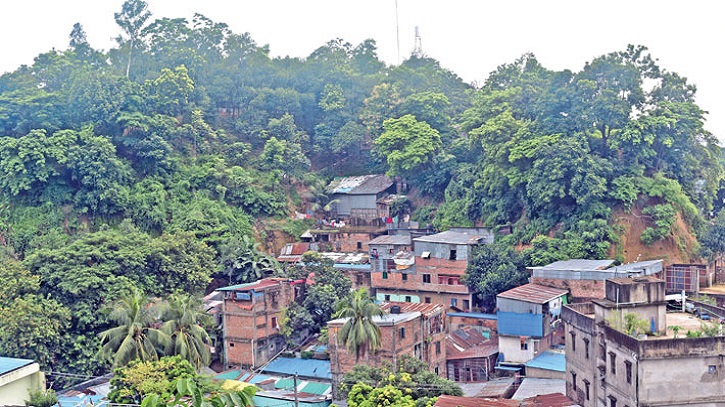Illegal settlements on the risky foothills of the port city and surrounding suburbs are escalating, provoking grave concerns amid a history of devastating landslides and tragedies.
Despite the existence of a hill management committee formed in the aftermath of a devastating landslide in 2007, most of the committee’s decisions have not been implemented.
This has led to an alarming increase in the number of families living in these high-risk areas.
Data from the Chattogram district administration indicates that the number of families residing on risky slopes in the city has jumped from 835 in 2019 to a staggering 6,558 currently.
These families predominantly consist of people from the lower-income groups such as garment workers, hawkers, rickshaw-pullers, and day-labourers. They choose to live in these perilous locations to avail of cheaper accommodation close to the city centre.
Areas like Motijharna, TankirPahar, Batali Hill, Foy’s Lake, Sholoshahar, and Kushumbag have seen an influx of residents despite the evident risks.
Environmentalists have blamed several factors for this dire situation. The hill owners’ indifference, lack of action from the district administration and other government agencies, and the absence of legal action against encroachers have contributed to the problem.
Adding fuel to the fire is the involvement of politically influential individuals who develop illegal houses on these lands, with the aim of renting them out to people with lower incomes.
This correspondent observed first-hand the hazards faced by people living in these settlements. Bashir Mian, a hawker who resides with his family in the Matijharna area, explained the difficult choices they face.
“It is not possible to have a rented house at a cheaper rate at a suitable place in the city. We have no alternative but to stay near the city centre to earn our bread, even if it means risking our lives,” said Bashir.
The current scenario is all the more concerning in light of the several hundred people who have lost their lives due to landslides in the city and its suburbs over the past two decades.
Most notably, torrential rains triggered massive landslides on June 13, 2017, resulting in 164 deaths across five districts including Chattogram.
Of them, 120 people were killed in Rangamati, 35 in Chattogram, six in Bandarban, two in Cox’s Bazar and one in Khagrachhari.
Ownership of the 26 hills in the city is also divided. Sixteen are owned by government organisations, including Bangladesh Railway, which owns seven; the National Housing Authority and Chattogram City Corporation own two each, and the Public Works department owns one. The remaining ten are privately owned.
The recurrent issue of landslides in Chattogram has a long and tragic history, exemplified by the catastrophe on June 11, 2007, that claimed 127 lives in just one day. This year, on August 27, a landslide in the Sholoshahar area led to the death of a father and his seven-month-old daughter, with two additional family members sustaining injuries.
Railway employee Abdul KhalekChowkidar is embroiled in controversy for levelling hills to develop approximately 100 tin-roofed houses in the area. These homes were primarily rented to individuals from lower-income groups. Despite the filing of a case against Khalek by both the Department of Environment and the victims’ relatives, he remains at large.
In the aftermath of the 2007 disaster, a hill management committee was formed on July 16, 2008. The committee has made various recommendations over the years, such as relocating vulnerable families, providing financial assistance, and severing illegal utility connections.
During its 27th meeting on August 8 this year, the committee reiterated the need for ongoing eviction drives, prepared lists for illegal settlements, and discussed plans for recovering and protecting hills through afforestation and fencing. Unfortunately, there has been negligible progress in implementing these resolutions.
Railway East Chief Estate Officer SujanChowdhury acknowledged conducting eviction drives at two locations, including Sholoshahar. However, he cited a lack of magisterial support from the district administration as a hurdle to broader eviction efforts. He also admitted that the list of illegal residents has not been updated for two years due to insufficient manpower, suggesting that an independent survey organisation could assist in this matter.
Meanwhile, Chattogram City Corporation Estate Officer RezaulKarim confirmed the preparation of a list of illegal occupants. Although eviction drives have been planned, they have been hampered by inclement weather conditions.
The failure to conduct eviction drives is due to unfavourable weather conditions, as disclosed by Chattogram City Corporation Estate Officer RezaulKarim. He mentioned that they would soon seek magistrate support from the district administration to carry out the evictions.
Chattogram Deputy Commissioner Abul Bashar Mohammed Fakhruzzamanemphasised the responsibility of hill owners in maintaining control over their lands post-eviction to prevent encroachment from recurring.
“We do execute evictions, but the onus is on the hill owners to put up fencing and take other preventative measures,” he stated. He also recommended stringent measures against hill cutting and illegal encroachments as deterrents to hazardous settlements.
When asked about more permanent solutions like rehabilitation, the Deputy Commissioner indicated that relocating such a large population within the city would be unfeasible. He suggested that people might instead utilise the government’s Ashrayan projects in their village homes.
Researchers and environmentalist Professor DrEdrise Ali criticized the inaction and apathy exhibited by the administration and other government bodies, as well as the lack of accountability among hill owners.
Dr Ali asserted that the situation is exacerbated by the motive of profiteering from illegal settlements. He called for the identification and legal prosecution of those who engage in hill cutting, risky property development, and other forms of business that contribute to the long-standing issue.
Moreover, Dr Ali underscored the need for coordinated efforts from hill owners and relevant government agencies to put an end to the perilous living conditions.
Source: The Daily SUN.

